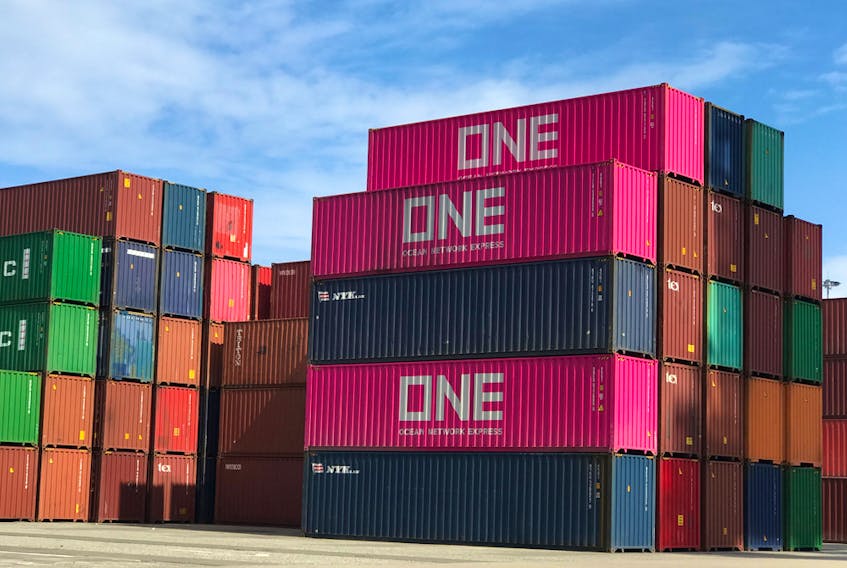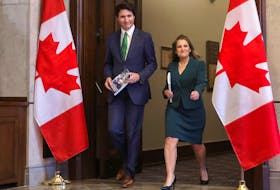TSAWWASSEN, B.C. — A longshore crane operator sits in front of a screen in the control room at Canada’s largest container terminal and moves a joystick ever so slightly to the left, remotely guiding a 40-foot container with a video-game-like interface.
He’s controlling the container for the last six to nine feet of a journey that’s highly automated from the moment it’s lifted off a ship docked at the man-made Pacific coast peninsula until it’s placed on a train bound, over a narrow causeway, for Calgary, Edmonton, Chicago or Memphis to deliver yoga pants, mandarins and furniture from Asia.
Once he places the box, a job humans are still better at than machines, the computer takes over again, directing the crane to pluck the next container from a brightly coloured Tetris stack and carry it to its optimal spot, repeating this process about 90 times an hour to load and offload up to 13 miles of double-stacked trains every day.
In the year since the technology was introduced at GCT Deltaport, the time imported rail containers spend on-dock has dropped to 2.1 days, as of July, from an average of 4.4 days in 2018. The eight new electric-powered semi-automated cranes have fuelled labour strife with the longshore union over feared work reductions, but they’ve also made the terminal the most automated rail-loading facility in North America, perhaps, executives say, even the world.
They are part of GCT Global Container Terminals Inc.’s private $300-million cash injection to increase capacity at the terminal, which handled 1.8 million 20-foot equivalent units (TEUs) in 2018, the second year in a row of record cargo volumes across Vancouver’s entire port system, Canada’s largest by far.
The cranes are also representative of the influx of investments from industry players, both private and public, to boost volume, improve efficiency and remove bottlenecks in a port-and-rail system under pressure to run smoothly to deal with increasing east-west trade under Canada’s new trade deals with Europe and Asia.

Congestion is a dirty word in this environment, and though operations may be running relatively smoothly for now, the potential menace of unwanted time delays haunts industry players debating what to build where — and with whose money — to avoid a long-term capacity crunch that could hurt B.C.’s ability to compete with West Coast terminals in the United States.
Here, congestion occurs, roughly, when more than 85-to-90 per cent of the capacity at a given terminal is in use. As of last year, B.C.’s container ports operated at about 82-per-cent capacity, said GCT chief executive Doron Grosman in an interview, a sweet spot where movement isn’t clogged, but the assets are working hard.
As such, the dreaded C word will not imminently choke B.C. container terminal operators and their landlords, the port authorities in Vancouver and Prince Rupert, who give credit to the billions of dollars in private and public investment spent on a series of expansion projects that are forecast to supply enough capacity until about 2030.
“There’s been a lot of money spent, there’s been a lot of improvements made, but we’re also handling 30 million more tonnes of volume,” Peter Xotta, vice-president of planning and operations at the Vancouver Fraser Port Authority, said in an interview this spring, noting that overall cargo hit 147 million tonnes last year, up from 115 million tonnes a decade ago.
“The underlying challenge is we’re growing at a rate that is putting pressure on supply chains. The concern that we have is that we’re not doing enough fast enough to stay ahead of that.”
The federal Liberals haven’t ignored the ports in their infrastructure spending spree. A series of summertime funding announcements even prompted the Conservatives to complain to the elections commissioner in advance of the October vote.
This week, the feds will announce a $153.7-million investment in three projects to increase capacity at the Port of Prince Rupert, which ships from Asia can reach one day faster than any other port along North America’s west coast. It will put $60 million towards the port authority’s double-track bridge across the Zanardi Rapids, $43 million on a rail transfer hub for Ridley Island’s bulk and container facilities, and $49 million towards a logistics facility built by the Metlakatla Development Corp.
It’s the single largest public investment Prince Rupert has ever received and more than it has received over the past 20 years in total, the port’s chief executive Shaun Stevenson said.
“It primes what will be billions of dollars of private-sector investment in terminals,” he said. “It’s great for Canadian exporters.”
The money, which will help build a bridge, rail transfer hub and logistics facility, is part of a federal effort to speed up spending from the National Trade Corridors Fund. Ottawa originally planned to spend $2 billion over 11 years, but it has already spent $1.7 billion on 81 projects since 2017. In January, it launched a continuous call for projects to get merit-based funding out the door more quickly, and the 2019 budget added an additional $400 million to the pot for spending in the North, where climate change can exacerbate existing transportation challenges.
“The Government of Canada, because of the incredible demand for this program, the popularity, if I can put it that way, realized a while back … we should spend it more quickly,” Transport Minister Marc Garneau said.

Canada’s geography and winter weather conditions make efficient and reliable transportation challenging, but getting goods to market is essential, Garneau said.
Federal policy explicitly linked transportation and trade for the first time in 2006 when the Conservatives dedicated more than $1 billion to the Asia-Pacific trade corridor.
A big ticket item for B.C. under that plan was the $658-million South Fraser Perimeter Road ($365 million came from the feds, the rest from the province). The highway, which separates commercial and residential traffic and connects Deltaport to major trucking destinations, has cut travel times in half since it opened in 2013, according to the port.
The Liberals built on that funding as officials signed off on two major trade deals: the Canada-European Union Comprehensive Economic and Trade Agreement (CETA) in 2016 and the Comprehensive and Progressive Agreement for Trans-Pacific Partnership (CPTPP) in 2018. The government also renegotiated the North American Free Trade Agreement, but that has yet to officially pass, making the push to diversify trade all the more critical.
The U.S. is still Canada’s largest trading partner by far, with $741.4 billion in imports and exports, but trade is growing with other partners. From 2015 to 2018, trade with Asia (excluding the Middle East) increased 18.9 per cent to $199.2 billion and trade with the European Union was up 19 per cent to $118.1 billion, according to government data.
Despite uncertainty in global trade markets, where a U.S.-led shift towards protectionism and a U.S.-China trade war have roiled the status quo, Garneau isn’t worried about building too much capacity in Canada’s transportation system.
“Ultimately, I’m sure that we will build on our trade with China … sometimes there can be challenges in terms of trade negotiations. That happens,” he said. “We need to continue building capacity. We’ve got good products, we’ve got to get them there on time.”
Ports, which, by the nature of their investments must plan five, 10, even 20 years in the future, also expect trade to recover in the long term. Trade tensions, particularly with China, could be acute and painful in the short term, but the Port of Vancouver’s Xotta said he’s optimistic relations will stabilize in the medium term.
“People want what Canada has,” he said. “We have high-quality, stable, reliable sources of supply for food products. It’s not a bad business to be in internationally.”
In the meantime, ports want to eliminate potential bottlenecks.
For terminal operators such as GCT, that can mean buying more efficient cranes to move more goods on the same footprint. For port authorities, which own federal land and lease it to private operators, that often means figuring out how to eliminate interactions between railways and roads in major metropolitan areas where ports and railways compete for space with growing populations.
These “last mile” hot spots can snarl both consumer traffic and goods movement, a pronounced challenge given railways now run longer trains in their own bid for efficiency. Vancouver’s port authority has a list of intersections where building overpasses and underpasses is key to moving goods, which, in turn, increases safety and reduces congestion and greenhouse-gas emissions.
The federal government also introduced measures to deal with railway congestion in updates to the Canadian Transportation Act last year.
Under the new rules, it launched an investigation into whether railways unfairly prioritized certain commodities during a particularly harsh winter after some shippers, particularly from the forestry industry, reported longer-than-usual wait times to get their products to markets.
Even in its investigation, congestion is a dirty word, at one point referred to as “alleged congestion.” Ultimately, it ordered Canadian National Railway Co. to submit a plan that addresses shippers’ concerns about traffic surges.
Many of the projects that help remove bottlenecks across the system have price tags in the tens of millions of dollars, but the port authority and its terminals are also thinking — and disagreeing in some cases — about the next few billion dollars they must spend to prepare for the demand they expect by 2030.
For example, GCT wants to build a fourth berth at its Deltaport facility, a $1.6-billion expansion project, while the port authority’s vision is to build a new island for a second terminal. GCT has the majority of the market share in Vancouver (though its competitor, DP World, is also expanding there and in Prince Rupert), so the port is seeking a different operator for its proposed terminal. Plus, the port argues, its proposed location is better for the environment.
GCT, which is fighting the port’s dismissal of its expansion plans in court, argues its proposal adds the same capacity at a lower cost and uses private, not public, capital. It takes a wider view of competition that includes ports in Seattle, Los Angeles and Long Beach, Calif., not just between operators in the Lower Mainland or between Vancouver and Prince Rupert.
Fortunately, it’s faster to ship to Canada from many places in Asia, GCT’s CEO Grosman said, so operators need to ensure they keep attracting business to B.C. He expects the majority of manufacturing to stay in Asia, despite pressure from U.S. President Donald Trump, given it has the know-how and people to do the work, and, as a result, he expects container volume to keep growing.
To meet that demand and to set Canada up for future success, he said the private sector and ports need to collaborate to keep goods moving. Port cities that make the wrong decisions can see terminals close as other locations pick off their business.
“You make a decision today,” Grosman said, “and you live with the consequence for the next 25 years.
Financial Post
• Email: [email protected] | Twitter: theemilyjackson
Copyright Postmedia Network Inc., 2019








